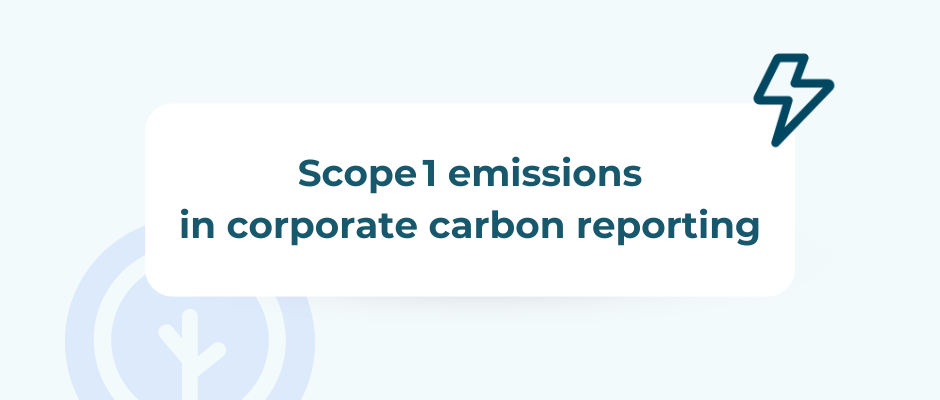Scope 1 emissions in corporate carbon reporting
Reading time: 6 minutes
Reading time: 6 minutes

As a company preparing a corporate carbon report, you must accurately quantify and manage your Scope 1 emissions. These are your direct greenhouse gas emissions, generated from sources you own or control. Understanding them is foundational to a credible carbon accounting process and underpins your compliance with evolving frameworks like the GHG Protocol Corporate Standard.
In this article we explain what Scope 1 emissions cover, why reporting them matters, and how to calculate them step by step. You’ll discover best practices in data collection, emission factor selection, and verification—plus reduction strategies including fuel switching and fugitive emissions control. We also explore how to integrate Scope 1 into broader carbon reports under ISO 14064 and prepare for regulatory demands such as the SEC’s climate disclosure rules, the EU’s CSRD or ISSB standards.
Throughout, we include real examples and a fresh perspective on monitoring and digital tools. After reading, you’ll have a clear roadmap to measure, reduce and report your Scope 1 emissions with confidence.
Scope 1 emissions refer to direct greenhouse gas emissions from sources you own or control. According to the GHG Protocol, they include emissions from stationary combustion (e.g. boilers, furnaces), mobile combustion (company vehicles, machinery), industrial process emissions, and fugitive emissions such as refrigerant leaks.
They are part of a broader categorisation of greenhouse gas emissions: Scope 1, 2 and 3 emissions. Scope 1 represents direct emissions, Scope 2 refers to indirect emissions from purchased electricity and heat, and Scope 3 emissions include all other indirect emissions in your value chain—from purchased goods to employee commuting.
Typical sources of Scope 1 emissions include:
For example, a brewery using natural gas boilers and forklifts burning diesel will report those emissions under Scope 1.
This definition draws directly from the GHG Protocol Corporate Standard, the international benchmark for carbon accounting used by thousands of organisations worldwide. It’s also in line with the Bilan Carbone methodology developed by the Association Bilan Carbone (ABC) in France.
In Europe, Scope 1 emissions reporting is becoming increasingly regulated at both EU and national levels. The Corporate Sustainability Reporting Directive (CSRD) requires large companies to disclose their direct greenhouse gas emissions, including Scope 1, from 2025 onwards. These disclosures must align with the European Sustainability Reporting Standards (ESRS).
France already mandates emissions reporting through its Article 173 of the Energy Transition Law, and the Bilan Carbone methodology explicitly includes Scope 1 as a required component of a carbon assessment. The Netherlands, Germany, and Sweden have also introduced or are preparing frameworks requiring large organisations to account for direct emissions, often aligned with the GHG Protocol or ISO standards.
Reporting Scope 1 is therefore not just a best practice—it’s a growing legal obligation across Europe.
Investors, customers and partners expect transparency in emissions data. Scope 1 figures reflect operational risk, transition exposure and credibility. Greenwashing—omitting Scope 1 or Scope 3 emissions—can damage trust, as seen in major net‑zero pledges that exclude full value‑chain impacts.
Tracking Scope 1 emissions often reveals energy inefficiencies. Reducing fuel consumption, improving fleet management, or fixing leaks can deliver direct cost savings alongside emissions reductions—a business‑and‑environment win.
Begin with an inventory management plan that defines both organisational boundaries (legal entities, sites) and operational boundaries (owned vs leased assets, mobile vs stationary sources).
Collect accurate data on:
Apply standard emission factors (e.g. EF per litre of diesel) sourced from recognised agencies such as EPA or national agencies. Calculate emissions by multiplying activity data by appropriate factors.
Use software platforms (like Tapio’s carbon management software) to centralise data, automate calculation, and visualise results in real time. Implement third‑party verification to ensure transparency and credibility, following EPA’s phased assurance model from entry to advanced level.
1. What’s included in scope 1 emissions reporting?
Scope 1 covers direct emissions from fuel combustion (stationary boilers, generators), fleet vehicles (mobile combustion), industrial process releases and fugitive gases like refrigerants or fire suppression leaks.
2. How do I calculate scope 1 emissions for company vehicles?
Track fuel consumption or mileage for owned or leased vehicles. Use standard emission factors (e.g., kg CO₂ per litre diesel) to compute emissions. Maintain logs monthly for accuracy.
3. Is Scope 1 separate from Scope 2 and 3?
Yes. Scope 1 is direct emissions from owned or controlled sources. Scope 2 covers indirect emissions from purchased energy (electricity, steam), and Scope 3 covers all other indirect value‑chain emissions.
4. Are Scope 1 emissions mandatory to report?
Yes. Major frameworks including the GHG Protocol, SEC (from 2025 rules), EU CSRD and ISSB require Scope 1 disclosures from publicly listed and large companies.
5. What tools help reduce scope 1 emissions?
Carbon management platforms, IoT energy sensors, fleet efficiency software, regular leak detection and alternative fuel or electrification measures.
Tracking and reducing Scope 1 emissions is a critical component of corporate sustainability. It’s increasingly regulated, highly visible to stakeholders, and full of opportunity for cost savings and climate impact.
Tapio’s carbon management software makes it easier to identify your emissions, plan reductions, and report with clarity and compliance.
Contact us to discuss how you could reduce your Scope 1 emissions.

Tapio is a carbon management software that allows companies and consultants to calculate and reduce carbon emissions.